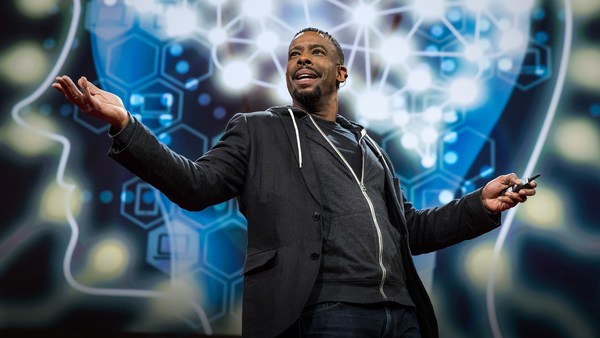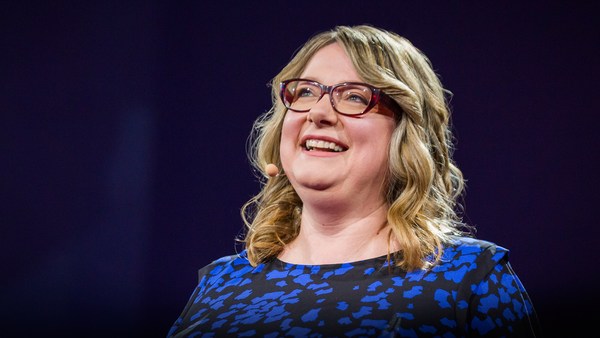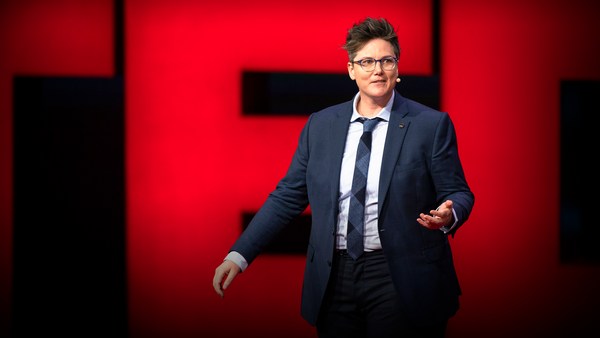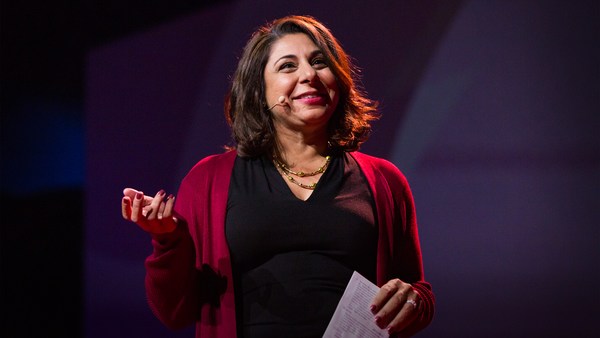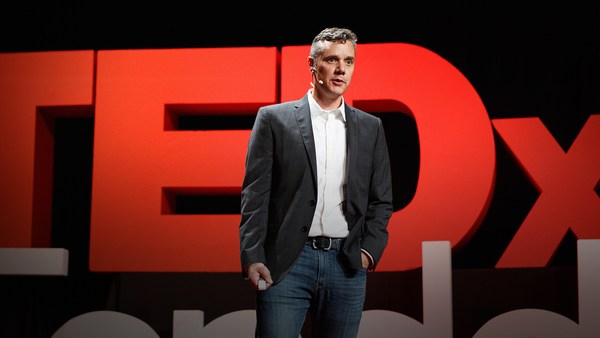[This is an improvised talk (and intro) based on a suggested topic from the audience. The speaker doesn't know the content of the slides.]
Moderator: Our next speaker --
(Laughter)
is an -- incredibly --
(Laughter)
Is an incredibly experienced linguist working at a lab at MIT with a small group of researchers, and through studying our language and the way that we communicate with other people, he has stumbled upon the secret of human intimacy. Here to give us his perspective, please welcome to the stage, Anthony Veneziale.
(Applause)
(Laughter)
Anthony Veneziale: You might think I know what you're going through. You might be looking at me here on the red dot, or you might be looking at me on the screen. There's a one sixth of a second delay. Did I catch myself? I did. I could see myself before I turned, and that small delay creates a little bit of a divide.
(Laughter)
And a divide is exactly what happens with human language, and the processing of that language.
I of course am working out of a small lab at MIT.
(Laughter)
And we are scraping for every insight that we can get.
(Laughter)
This is not often associated with a computational challenge, but in this case, we found that persistence of vision and auditory intake actually have more in common than we ever realized, and we can see it in this first slide.
(Laughter)
(Applause)
Immediately your processing goes to, "Is that a hard-boiled egg?"
(Laughter)
"Is that perhaps the structural integrity of the egg being able to sustain the weight of what seems to be a rock? Aha, is it in fact a real rock?" We go to questions when we see visual information. But when we hear information, this is what happens.
(Laughter)
The floodgates in our mind open much like the streets of Shanghai.
(Applause)
So many pieces of information to process, so many ideas, concepts, feelings and, of course, vulnerabilities that we don't often wish to share. And so we hide, and we hide behind what we like to call the floodgate of intimacy.
(Laughter)
And what might that floodgate be holding? What is the dike upon which it is built? Well, first off --
(Laughter)
we found that it's different for six different genotypes.
(Applause)
And, of course, we can start categorizing these genotypes into a neuronormative experience and a neurodiverse experience.
(Laughter)
On the right-hand side of the screen, you're seeing spikes for the neurodiverse thinking. Now, there are generally only two emotional states that a neurodiverse brain can tabulate and keep count of at any given time, thereby eliminating the possibility for them to be emotionally, sometimes, attuned to the present situation. But on the left-hand side, you can see the neuronormative brain, which can often handle about five different pieces of emotional cognitive information at any given time. These are the slight variances that you are seeing in the 75, 90 and 60 percentile, and then of course that dramatic difference of the 25, 40 and 35 percentile.
(Laughter)
But of course, what is the neural network that is helping to bridge and build these different discrepancies?
(Laughter)
Fear.
(Laughter)
(Applause)
And as we all know, fear resides in the amygdala, and it is a very natural response, and it is very closely linked with visual perception. It is not as closely linked with verbal perception, so our fear receptors often will be going off in advance of any of our cognitive usage around verbal and words and cues of language. So as we see these fear moments, we of course are taken aback. We stumble in a certain direction, generally away from the intimacy.
(Laughter)
Now of course, there's a difference between the male perception and the female perception and of trans and those who are in between, all of those as well, and outside of the gender spectrum.
(Laughter)
But fear is the central underlying underpinning of all of our response systems. Fight-or-flight is one of the earliest, some say reptilian, response to our environment.
How can we disengage or unhook ourselves from the horns of the amygdala?
(Laughter)
Well, I'd like to tell you the secret right now.
(Applause)
This is all making much, much too much sense.
(Laughter)
The secret lies in turning our backs to one another, and I know that that sounds absolutely like the opposite of what you were expecting, but when in a relationship you turn your back to your partner and place your back upon their back --
(Laughter)
you eliminate visual cues.
(Laughter)
(Applause)
You are more readily available to failing first, and failing first --
(Laughter)
far outweighs the lengths we go to to appeal to others, to our partners and to ourselves. We spend billions and billions of dollars on clothing, on makeup, on the latest trend of glasses, but what we don't spend money and time on is connecting with each other in a way that is truthful and honest and stripped of those visual receptors.
(Applause)
(Laughter)
It sounds hard, doesn't it?
(Laughter)
But we want to be aggressive about this. We don't want to just sit on the couch. As a historian said earlier today, it's important to get up and circumvent sometimes that couch. And how can we do it? Well yes, ice is a big part of it. Insights, compassion and empathy: I, C, E.
(Applause)
And when we start using this ice method, well, the possibilities become much bigger than us. In fact, they become smaller than you. On a molecular level, I believe that that insight is the unifying theme for every talk you have seen so far at TED and will continue as we of course embark on this journey here on this tiny planet, on the ledge, on the precipice, as we are seeing, yes, death is inevitable.
(Laughter)
Will it meet all of us at the same time, I think, is the variable we are inquiring.
(Laughter)
I think that timeline gets a bit longer when we use ice and when we rest our backs upon one another and build together, leaving behind the fear and working towards --
(Laughter)
they'll edit this part out --
(Laughter)
a ripened experience of love, compassion, intimacy based on a truth that you are sharing from your mind's eye and the heart that we all can touch, tactilely feel, have maybe potentially a mushy experience that we don't just throw out because it is browned, but let us slice in half the experience we have gathered, let us seed what the heart, the core, the seed of that idea in each of us is, and let us share it back to back.
Thank you very much.
(Applause)
